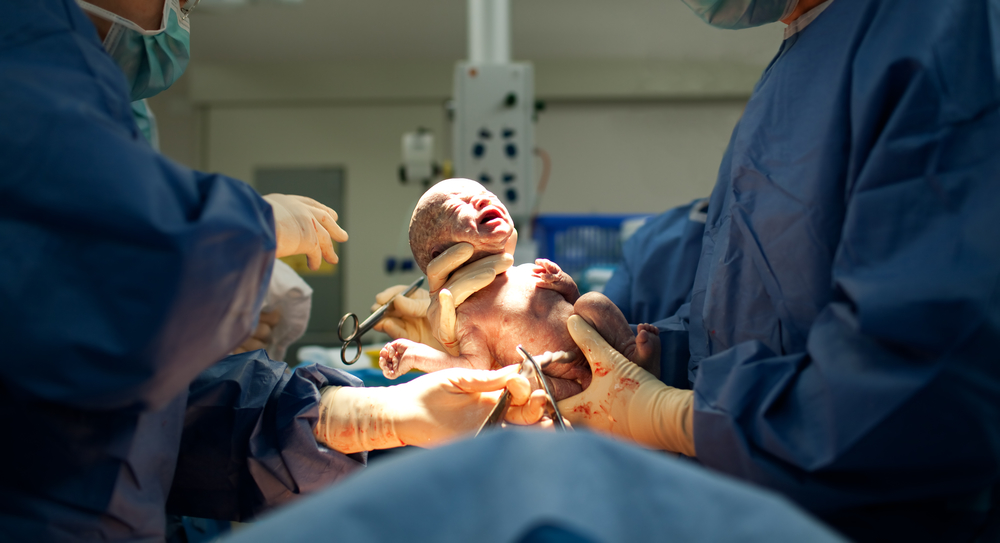What is a Caesarean section?
A Caesarean or C-section is a surgical procedure of giving birth. It involves an obstetrician making a cut into mother’s lower stomach and uterus to deliver a baby. While they can be optional which are referred to as an elective Caesar, there are many medical reasons why this method of delivery is used. The most common is during an emergency where you or your baby are in distress.
 How long does a caesarean take?
How long does a caesarean take?
Most women are surprised to find out that this surgical procedure can take up to 30 minutes not including the anaesthetic work and stitching you back up.
Types of Anaesthetic during a caesarean
Don’t worry you won’t feel much if any pain during while delivering via c-section. Your medical team will decide which method of anesthesia is most appropriate for you.
Most anesthetists start with a local anaesthetic before using either an epidural or a spinal block, so you don’t feel the needle for an epidural or spinal block going in.
An epidural uses a small catheter near the spinal cord to inject anaesthetic which can be topped up if it wears off. There are different doses of this, so the doctors will prescribe what is most appropriate. During the epidural, you can move (but not walk or stand) and feel your lower body, but not feel the intensity of a contraction, which is why most anesthetists chose a spinal block during a c-section.
A spinal block is like an epidural however a single dose is injected into the spinal fluid around the spinal cord which makes your lower half completely numb, which means you won’t feel any incisions being made to deliver your baby. You will not be able to feel or move from this point on until a few hours post-op.
In an emergency or if the spinal or epidural don’t work you may be put under a general anaesthetic.
Can anyone get a C-section?
Yes, you can request this from your obstetrician, this is usually done if you are due to travel, or have an event or more commonly, have a medical reason like your baby is looking to be quite large and may become too hard to deliver vaginally. It is something you will need to come to agreement with your obstetrican. This can be planned well in advanced but if your labor hasn’t progressed or if you have been in labour too long your obstetrician may ask if you’d like to take the c-section route.
If it is unplanned an emergency c-section may be done because the mother or baby’s health is in jeopardy.
What are the risks of getting a C-section?
It’s important to remember that a c-section is still major surgery which like any medical procedure carries risks. Some of the major risks are:
- A longer stay in hospital
- Blood loss
- Blood clots in the legs
- Pain around the wound
- Internal infections
- Infections of the wound
- Problems with future attempts at vaginal birth
- Complications from anaesthetic
- Abdominal pain or wound that is getting worse and isn’t relieved with pain-relieving medication
- Pain where you had the epidural or spinal injection
- Pain or burning when you pass urine
- Leaking urine
- Constipation
- Unusual bowel motions
- Increased vaginal blood loss or smelly discharge from the vagina
- Swelling or pain in your calf
What is the caesarean recovery like?
After your c-section you will be given quite strong pain killers and anti-inflammatories which are safe to take while breastfeeding. Don’t be a hero and opt out as this will slow your recovery. Your nurses will likely check your wound and stitches post-op and for the day after. Most women will go home anywhere from 3 to 5 days post-partum. This doesn’t mean life goes back to normal, you should still take it easy and not lift heavy weights, drink plenty of water and rest as much as baby allows while recovering from a caesarean. It’s important that you keep your wound clean and dry. Cramping and some pain is normal and some doctors will prescribe pain killers for the days after you go home. Most women don’t feel 100 per cent for at least 6 weeks. If there are any concerns like pain, swelling, high fever of heavy bleeding from the vagina (if you’re soaking a sanitary pad an hour) you should seek medical assistance.
Breastfeeding after a caesarean
Factors such as type of anaesthetic and recovery can have some impact of breastfeeding post caesarean. Where possible, remind the doctor and midwives that you wish to breastfeed as soon after birth as possible. If possible aim for skin to skin contact between mum and baby either in the operating room or in the recovery room.
There may be a slight delay to milk coming in after a caesarean, however it should not impact your ability to breastfeed. More information on breastfeeding after a caesarean is available from the Australian Breastfeeding Association.
Community tips about caesareans
- What to pack for a caesarean
- Community C-section expereinces
- Experience with multiple c-sections
- C-section experiences under general anaesthetic
- Doctor recommended a c-section
Whether you give birth via caesarean or vaginally, it still leads you to the beautiful path of being a mother. No matter what your birth story is, it is one you won’t soon forget.

 How long does a caesarean take?
How long does a caesarean take?











